Extreme athleticism can take a toll on figure skaters' bones and joints

Overhead lifts, quad jumps, double Salchows and sit spins—the artistry of figure skating is awe inspiring, but these moves also require extreme athleticism, which can take a toll on the body's bones and joints.
Some of Canada's top figure skaters are participating in a new research study in the Cumming School of Medicine's Centre for Mobility and Joint Health (MoJo), located in the McCaig Institute for Bone and Joint Health, that looks at the relationship between training frequency, impact load, nutrition and bone microarchitecture. The findings of this study, designed in partnership with the Canadian Sport Institute (CSI) Calgary, Skate Canada, and funded by the Own the Podium Innovations for Gold initiative, will inform health guidelines in the prevention, early detection and treatment of bone and joint injuries in elite and developing Canadian figure skaters.
"Minimizing training time loss due to injury is important in elite sport," says CSI Calgary's Research and Innovation Lead, Erik Groves. "Partnering with the MoJo and its world-leading researchers and technology is invaluable to us for evaluating bone health and injury risk in high performance sport."
Training frequency, impact load and nutrition play an important role in bone health
Impact load (force applied to the skeleton during landing) has both a beneficial and detrimental effect on bones. Elite figure skaters train up to 30 hours per week, and they load one leg more than the other when they take off and land. The study will compare the bone strength of both the takeoff and landing leg.
"In good measure, weight-bearing exercise increases bone density and is vital for making bones strong and healthy," says Lauren Burt, research associate in the Centre for Mobility and Joint Health. "However, too much load can lead to bone weakness and stress fractures."
Good nutrition is also extremely important in maintaining strong bones. A lack of nutrients, such as vitamin D or calcium, can lead to osteoporosis. The study will look at how athlete nutrition impacts bone health.
"We'll be comparing the bone health of national team skaters and developing skaters, to determine what role training burden plays in injury," says Groves.
The research study includes the following:
- XtremeCT scans: The tibia and radius (shin and wrist) of athletes will be scanned to look at bone microarchitecture. These images will provide a detailed look at bone density and strength.
- A full body profile: This includes weight, height, and skinfold measurements of various points in the body.
- Food questionnaire: Participants fill out a detailed food frequency questionnaire to estimate nutrient intake.
- Health history: This includes blood work and a detailed account of previous injuries.
The study is recruiting 34 national team athletes and junior development athletes from across the country. Each skater will undergo testing a total of three times over a period of two years.




















